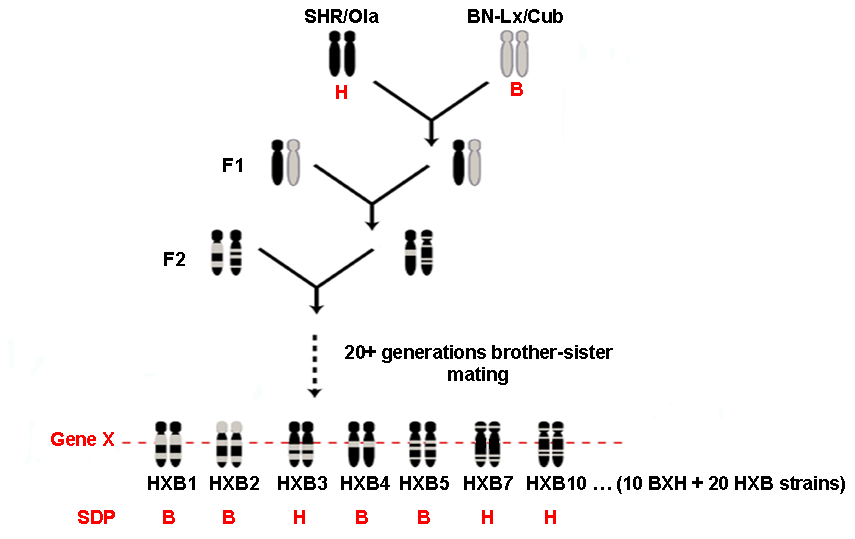The spontaneously hypertensive rats (SHR) is the most commonly used model of human essential hypertension and metabolic disorders typical of the metabolic syndrome. As in humans, these pathophysiological traits are multifactorial, i.e., determined by many genes and their interactions with environmental factors. Uncovering the responsible genes and thus the pathophysiological mechanisms underlying such complexly determined traits represents a major challenge for biomedical research, both in humans and in animal models. To uncover genes underlying spontaneous hypertension and metabolic disorders in the SHR strain, we generated a set of 30 HXB/BXH recombinant inbred (RI) strains. The RI strains are derived from F2 generation individuals obtained by crossing 2 highly inbred strains, SHR and BN-Lx. Randomly selected pairs from the F2 generation are bred by brother x sister mating for more than 20 generations to fix the recombinant genotypes. As a result of segregation and recombination, each RI strain has unique combinations of alleles from both parental strains. Because RI strains are inbred, it is possible to determine their pathophysiological traits as averages of several individuals. Accurate estimation of phenotype-genotype relationships is particularly important in analyses of highly variable traits such as blood pressure or behavioral phenotypes. Moreover, because all measurements from different studies and laboratories are cumulative in RI strains, it is possible to analyze relationships between these traits to a degree not possible in conventional genetically segregating populations. The genomes of all RI strains have recently been determined by a collaboration of laboratories grouped in the International Rat Omics Consortium (IROC).
For linkage and correlation analyses of hemodynamic and metabolic traits using RI strains, accumulated data are freely available in the online database and software Genenetwork. This database contains, in addition to physiological traits, intermediate phenotypes (transcriptome and proteome in a number of tissues of RI strains) that have simpler genetic determination, allowing their use for the discovery of genes underlying complex traits. For example, the fact that the renal expression (mRNA amount) of the mutant Cd36 (fatty acid translocase) gene can be mapped to the vicinity of the Cd36 locus (so-called cis-regulation), and the amount of renal Cd36 mRNA correlates with blood pressure, has revealed Cd36 as a gene that predisposes the SHR strain to hypertension (Pravenec et al., 2008).
Scheme for derivation of the HXB/BXH recombinant inbred strains.










